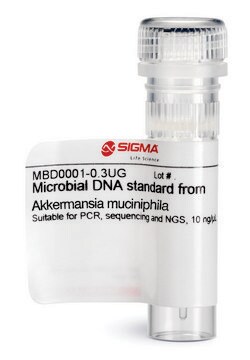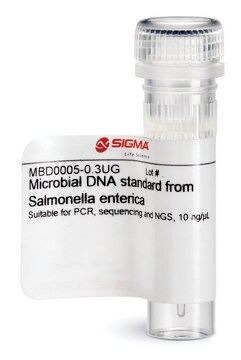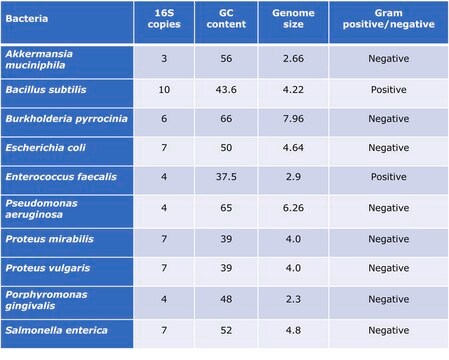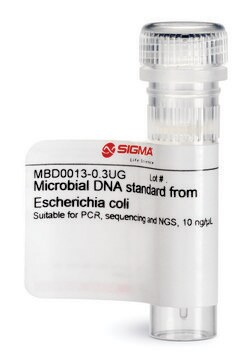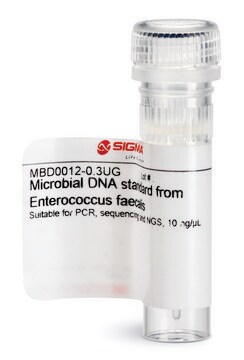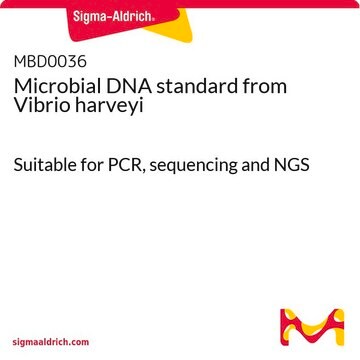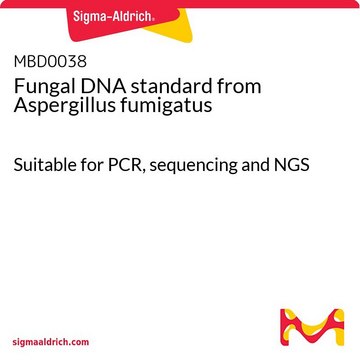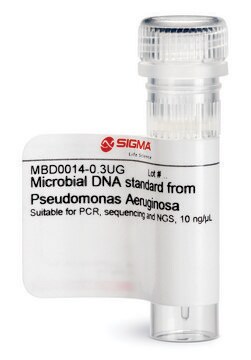MBD0023
Microbial DNA standard from Deinococcus radiodurans
Suitable for PCR, sequencing and NGS, 10 ng/μL
Faça loginpara ver os preços organizacionais e de contrato
About This Item
Código UNSPSC:
41105500
NACRES:
NA.24
Produtos recomendados
Nível de qualidade
forma
liquid
concentração
10 ng/μL
técnica(s)
DNA extraction: suitable
DNA sequencing: suitable
PCR: suitable
Condições de expedição
ambient
temperatura de armazenamento
−20°C
Descrição geral
Standardization of sample analysis is currently needed in microbiome genomics research workflow. Lack of standardization can lead to biases and errors in common processes during sample preparation and analysis such as sample amplification, sequencing and bioinformatics analyses.1 Deinococcus rediodurans genomic DNA microbial standard can serve as standard for benchmarking the performance along the workflow of microbiomics or meta-genomics analyses and as a tool to increase reproducibility and allow comparison of results obtained by different labs.Since Deinococcus radiodurans is not a typical resident of the human microbiota it can serve as a spike-in standard in human microbiota genomics workflow analysis.
Deinococcus radiodurans is an extremophilic, heterotrophic, non-motile, non-spore-forming, aerobic tetracoccus bacterium. 2 The cell envelope of Deinococcus radiodurans stains as a gram-positive, but the two membranes that separated by a peptidoglycan layer, makes it more similar to typical gram-negative bacteria. 3 Deinococcus radiodurans is an extremophilic microorganism that can survive harsh conditions such as cold, high temperature, acid, alkali, resistance to desiccation, oxidative stress, ionizing radiation and ultraviolet radiation. 3 Mechanisms responsible for these extremophilic characteristics include: efficient repair of DNA damage 4, 5, Nucleotides Excision Repair (NER) 6, unique DNA mismatch repair (MMR) method 7 and efficient cellular mechanisms such as proteolytic protein for removal damaged and misfolded proteins, Nudix hydrolase 8 a broad-spectrum of transcription factor and a unique regulatory protein, which stimulates recA gene transcription after exposure to ionizing radiation 9.The large tolerance of the extremophile, Deinococcus radiodurans to the extraordinary conditions makes this bacterium as a tool for metabolic engineering 10.
Read here how to use our standards to ensure data integrity for your microbiome research.
Deinococcus radiodurans is an extremophilic, heterotrophic, non-motile, non-spore-forming, aerobic tetracoccus bacterium. 2 The cell envelope of Deinococcus radiodurans stains as a gram-positive, but the two membranes that separated by a peptidoglycan layer, makes it more similar to typical gram-negative bacteria. 3 Deinococcus radiodurans is an extremophilic microorganism that can survive harsh conditions such as cold, high temperature, acid, alkali, resistance to desiccation, oxidative stress, ionizing radiation and ultraviolet radiation. 3 Mechanisms responsible for these extremophilic characteristics include: efficient repair of DNA damage 4, 5, Nucleotides Excision Repair (NER) 6, unique DNA mismatch repair (MMR) method 7 and efficient cellular mechanisms such as proteolytic protein for removal damaged and misfolded proteins, Nudix hydrolase 8 a broad-spectrum of transcription factor and a unique regulatory protein, which stimulates recA gene transcription after exposure to ionizing radiation 9.The large tolerance of the extremophile, Deinococcus radiodurans to the extraordinary conditions makes this bacterium as a tool for metabolic engineering 10.
Read here how to use our standards to ensure data integrity for your microbiome research.
Aplicação
The genomic DNA is provided at ≥10 ng/μl concentration in TE buffer pH 8.0.It is recommended to avoid freeze thaw cycles of this product.
Adequação
PCR, sequencing, next generation sequencing
forma física
Liquid -The genomic DNA is provided at ≥10 ng/μl concentration in TE buffer pH 8.0
Código de classe de armazenamento
12 - Non Combustible Liquids
Classe de risco de água (WGK)
WGK 1
Certificados de análise (COA)
Busque Certificados de análise (COA) digitando o Número do Lote do produto. Os números de lote e remessa podem ser encontrados no rótulo de um produto após a palavra “Lot” ou “Batch”.
Já possui este produto?
Encontre a documentação dos produtos que você adquiriu recentemente na biblioteca de documentos.
Nossa equipe de cientistas tem experiência em todas as áreas de pesquisa, incluindo Life Sciences, ciência de materiais, síntese química, cromatografia, química analítica e muitas outras.
Entre em contato com a assistência técnica
